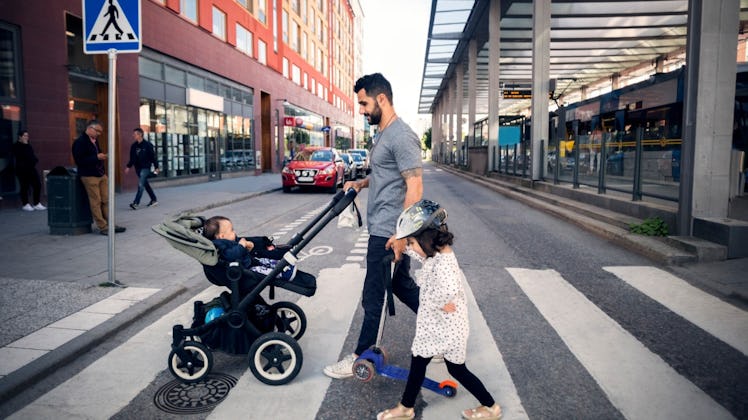Vehicle Safety Ratings Will Soon Focus on Pedestrian Safety, Too
Of car accident deaths of kids in 2019, 16 percent of victims were pedestrians and 4 percent were bicyclists.

The five-star safety rating — a key piece of information people look to when buying a new car, otherwise known as the New Car Assessment Program (NCAP), is being overhauled by the National Highway Traffic Safety Administration (NHTSA). Any parent buying a car has looked over the safety rating of the vehicles they are considering — it’s just part of the car buying process.
But for the first time ever, and amid a massive rise in traffic-related deaths of pedestrians, the NCAP and NHTSA are going to look again at how they rate vehicle safety. And this time, they’re not just going to think about people inside the cars and how they will fare in an accident — they’ll also look at how safe the cars are for the pedestrians around them who share the roads.
What Is The 5-Star Rating Safety System?
Right now, the 5-star rating safety system is basically made by the famous videos of crash test dummies driving into walls and seeing how they fare. The NHTSA “crash tests new vehicles and rates them on how well they protect occupants in frontal, side, and rollover crashes.” Cars that fare very well in keeping vehicle occupants safe are rated at 5 stars; cars that do less well closer to 1. There is no testing of, say, how the vehicle fares at keeping people outside of the car alive in accidents.
How a car is rated is federally required to be displayed on the vehicle at car dealerships. That coveted five-star rating is something that consumers really want — they want vehicles that keep them and their kids safe. Consumers can look at the NHTSA website to see how safe the car they want to buy is — and the program has been in place since 1993. And consumers can look up older, used models, for example, when trying to make their informed car-buying decisions.
Almost all of the new models that come onto the market yearly are tested by the NHTSA. (For 2022 models, 86 percent of new vehicles will be tested for the NHTSA 5-star safety rating program.) But the way vehicles are rated right now is outdated.
How Will it Be Overhauled?
Overhauling the 5-star review was something that President Obama directed his NHTSA to look into while he was president. This was halted under Trump, but has begun again under President Biden since his bipartisan infrastructure plan — one of the largest accomplishments of his presidency so far — passed.
The Verge reports that the plan requires new cars to include “forward-collision warnings, automatic emergency braking, and lane-keep assistance.” It also asks the New Car Assessment Program to include the braking, warnings, and lane-keep features in its 5-star safety rating system.
The safety rating, in other words, is no longer just about the safety of the riders in the car but the people who may be in space around it. It also means that cars that don’t have automatic braking or lane-keep assistance could be rated lower in their safety ratings.
Of course, the fine details aren’t yet hammered out on how they will be overhauling the safety rating system. Verge notes that the agency hasn’t determined whether it will look at automatic braking for cyclists, like car safety rating tests do in Europe, for example. But it’s a welcome step in the right direction at a time when roads are becoming way more dangerous.
Why Does It Matter?
Traffic-related deaths have been surging, even during the pandemic when people were driving less.
In 2020, 39,000 people were killed on the road or in traffic fatalities, a number not seen since 2007. 6,700 of those people were pedestrians — up 5 percent from the 2019 total. The pedestrian fatality rate also reached 21 percent in 2020, per Axios, showing that even though people were driving less, people were dying more. Bicycling deaths in the same year hit the highest number of deaths since 1987. Pedestrian deaths hit the highest number in 2020 since 1989. In other words, more people are dying on the road than have in many, many decades.
The NHTSA website reveals that 2021 will likely be no different, and probably worse for road safety. From January to September, at least 31,720 people died in traffic-related accidents, noting already a 12 percent increase from the number of people who died in traffic accidents in the first nine months of 2020, and the largest number of traffic deaths during the first nine months of any year since 2006. It’s also the “highest percentage increase” in deaths “during the first nine months [of the year] in the Fatality Analysis Reporting System’s history.”
Road safety is of particular importance to parents. Of car accident deaths involving kids in 2019, 16 percent of victims were pedestrians and 4 percent were bicyclists. The good news is that 2019 data from the Insurance Institute for Highway Safety and Highway Loss Data Institute has found that deaths of kids younger than 13 have declined since 1975, but updating car safety ratings will help keep them safer at a time when traffic deaths are climbing overall.
In a statement about the 2021 deaths, NHTSA’s Deputy Administrator Dr. Steven Cliff said, “We have to change a culture that accepts as inevitable the loss of tens of thousands of people in traffic crashes,” said Dr. Steven Cliff, NHTSA’s Deputy Administrator. “This will require a transformational and collaborative approach to safety on our nation’s roads.”
Having safe streets — and safer cars that help keep pedestrians and other people not in those cars safer — is a key part of having a family-friendly society.
This article was originally published on